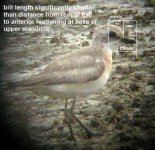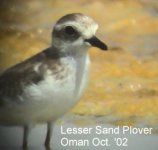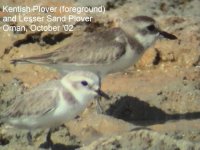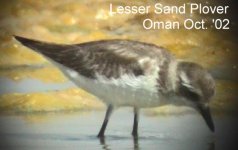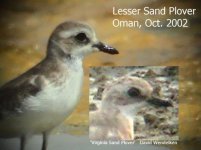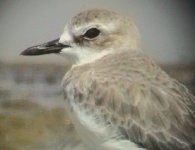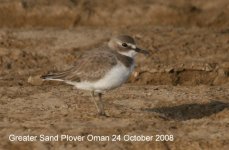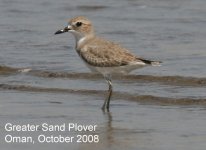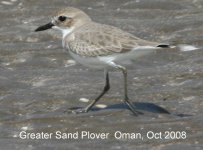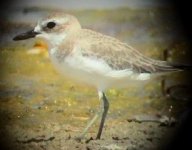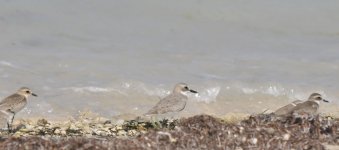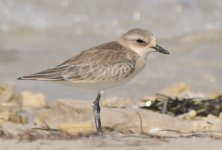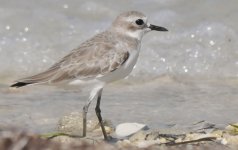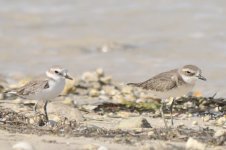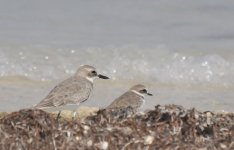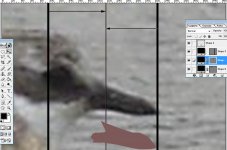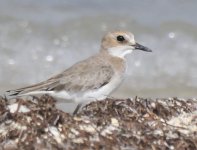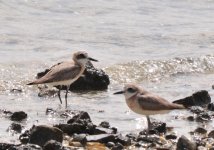The Virginia sand plover
Hello all,
I hope I will be excused for posting this reply to the ID Frontiers listserve here, where I can attach a few images. While I am at it, I would draw the attention of ID Frontiers subscribers who are new to Birdforum to check out Howard King's photos of Greater and Lesser Sand Plovers (posting #19, first page of this thread) taken in Bahrain in the past day or two.
I consider the single most important source of difficulty with Greater vs. Lesser Sand Plover, especially when it comes to identifying lone, out-of-range vagrants, to be the widespread perception that Lesser Sand Plover is always "small-billed". Some are (especially when compared with a typical Greater) but compared to Kentish/Snowy Plover, Lesser can, and often does have quite a stout, even moderately heavy bill. This impression may be enhanced if the feathering of the head is pressed close to the skull, or the opposite when the feathers are fluffed out a little, so even in the same individual, apparent bill size may not be constant.
So far as I am aware, most cases of sand plovers where the identification has been disputed have ultimately proven to have involved Lessers mistaken for Greaters, rather than he other way around.
I welcome Erik's explanation of what exactly he is seeing to make him think this bird is a Greater Sand Plover. In spite of my confidence that it is a Lesser, I have to admit that while examining some additional images (and especially the shaky video, here:
http://www.youtube.com/watch?v=tlBXJyK2tPw ) I too have felt moments of equivocation and wondered if perhaps I had got it all horribly wrong? This, however, is almost to be expected when looking at a long series of photos of any individual sand plover, especially when most are of poor quality; sooner or later an image will pop up that seems to completely contradict the images either side of it - it is not without good reason that sand plover identification has gained a reputation as one of the more perplexing ID topics we have to deal with in the Palearctic (and now, it seems in the Nearctic). But before we work ourselves up into a sweat, we need to remind ourselves that most of the time - especially when watching the two species together - they are actually rather easy to identify. Indeed, I think most people who see the two species regularly would agree that a typical Greater Sand Plover among Lessers stands out like a sore thumb.
As I mentioned in my previous post, my most recent experience with sand plovers has been in Oman, on the Persian Gulf. I have also studied them in Malaysia, Goa, Thailand and China, and had numerous opportunities to look at the potentially most problematic 'small' race of Greater, (
columbinus) during frequent visits to Israel throughout the 80s and 90s. At the risk of committing heresy, in my experience the challenge of telling two species apart is pretty much the same
regardless of the subspecies, as the problem is mostly to do with the inherent difficulty in assessing size, shape and proportions, which differ fairly consistently between the two species, but which are not always easy to determine reliably. Attempting this on the basis of a series of fuzzy photos is probably not a good idea...
Looking at the images on which Erik has concentrated, at:
http://birdtrek.smugmug.com/Animals...68310_w5mm7/1/643504800_jcKNB#643505797_4hgA7
I can certainly see some that are less obviously Lesser Sand Plover-like than others (for example images 11, 15 and 18). However none, in my opinion, approaches what I would expect to see in a
convincing Greater Sand Plover, especially an example of the larger billed
crassirostris/leschenaultii group. All of the images that show the bill in any way clearly against an evenly toned background (for example, 7, 8, 12, 13, 14 ,16 and 17) seem to me to show a bill that is much too short and stubby-tipped for any form of Greater Sand Plover.
I'm afraid I do not concur with overall impression alluded to by Erik of Greater being "better balanced" than Lesser, in fact I have gained an impression of quite the opposite! I think these kinds of impressions can change so much depending on posture, what the bird is doing, temperature etc. that they are of little practical use in resolving the identity of disputed birds. Likewise, subtle differences in the shape of the white wing-bar, tail pattern and degree of toe-projection in flight can confuse the issue as much as clarify it. Unfortunately, leg length and leg colour in these two species often do not correspond with what is 'typical'.
I have posted this response on Birdforum, where I will be able to attach images of some fairly large-billed Lesser Sand Plovers I have seen in Oman. I am also taking the liberty of posting a montage of one of David Wendelken's close-ups and the head of a Lesser Sand Plover I videoed in Oman, and the same shot again with a measurement of the bill-length: bill to eye ratio; I hope you don't object David. In a follow-up posting to Birdforum I will attach some Greater Sand Plover images, for comparison.
I may be mistaken in my belief that the Virginia sand plover is a stout-billed Lesser, but if the evidence can establish this conclusively, I for one will have learned something useful!
Killian Mullarney
Ireland





